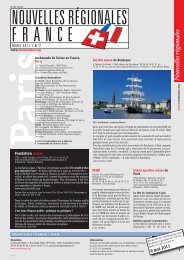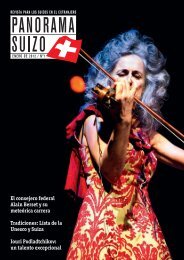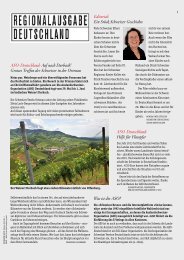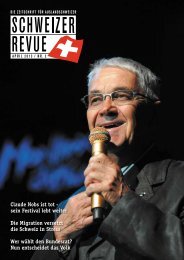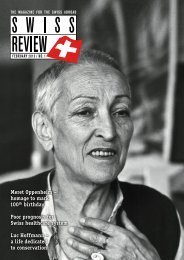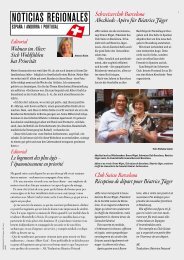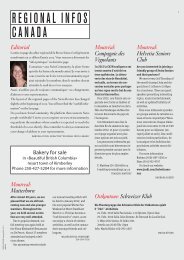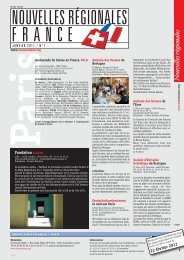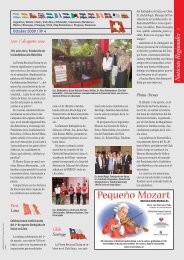Download PDF Swiss Review 3/2013 High ... - Schweizer Revue
Download PDF Swiss Review 3/2013 High ... - Schweizer Revue
Download PDF Swiss Review 3/2013 High ... - Schweizer Revue
Create successful ePaper yourself
Turn your PDF publications into a flip-book with our unique Google optimized e-Paper software.
8<br />
Focus<br />
Young politicians under the Federal Palace dome<br />
The proportion of National Councillors below the age of 40 stood at 18% at the 2011 elections. The number of young<br />
politicians has not been as high for almost a century. Who are these young high-flyers, and why are they being elected?<br />
By Seraina Gross<br />
They have not yet turned 30 but already they<br />
are well up the political career ladder. Among<br />
the young stars in the <strong>Swiss</strong> Parliament at the<br />
beginning of June, four National Councillors<br />
had yet to celebrate their 30th birthday.<br />
Young Socialist Cédric Wermuth was elected<br />
to the large chamber in Aargau at the age of<br />
just 25 at the federal elections in October 2011,<br />
as was Mathias Reynard, also aged 25, a<br />
teacher and Social Democrat from the village<br />
of Savièse in Valais. The others are two<br />
Bernese politicians, Aline Trede (29) of the<br />
Greens and Nadine Masshardt (28) of the Social<br />
Democrats. Both moved up to the Na-<br />
doubled in comparison to previous elections.<br />
It is in fact higher today than the proportion<br />
of the population that age group comprises,”<br />
Seitz remarks. The average age of National<br />
Councillors elected in 2011 stood at 50 – two<br />
years lower than in 2003. In 1999, two under-<br />
30s were elected to Parliament, while there<br />
were five in 2003, six in 2007 and four in 2011.<br />
The star from St. Gallen<br />
The election of Toni Brunner in 1995 caused a<br />
sensation. The young farmer and current<br />
Party President of the <strong>Swiss</strong> People’s Party<br />
(SVP) became the youngest National Coun-<br />
Brunner’s cow “Rösli” and his dog “Bäärli” became<br />
newsworthy. Today, almost 18 years and<br />
four National Council elections later, Toni<br />
Brunner – who is still under 40 – has long been<br />
a firm fixture in Berne. He failed to make the<br />
career step to the Council of States but he did<br />
succeed Ueli Maurer at the head of the SVP<br />
in 2008 following the latter’s election to the<br />
Federal Council.<br />
From “accident” to strategy<br />
The election of Toni Brunner marked the start<br />
of a trend. A few more young politicians have<br />
since made the step up to Berne every four<br />
Aline Trede, Greens Céline Amadruz, SVP Christian Wasserfallen, FDP<br />
<strong>Swiss</strong> <strong>Review</strong> June <strong>2013</strong> / No. 3<br />
Photos: donated<br />
tional Council at the beginning of March to<br />
replace party colleagues Franziska Teuscher<br />
and Ursula Wyss, who had been elected to<br />
Berne’s city government.<br />
While Switzerland’s population is ageing<br />
all the time, its politicians are getting younger<br />
and younger. The proportion of those under<br />
the age of 40 stood at 18 per cent at the 2011<br />
National Council elections. This is the highest<br />
figure for almost a hundred years, as an<br />
overview produced by the Federal Statistical<br />
Office reveals. You would have to go back to<br />
1919 to find a comparably high proportion of<br />
National Councillors aged under 40, at 21.2<br />
%. Werner Seitz, a political scientist at the<br />
Federal Statistical Office, points out that<br />
there has primarily been an increase in the<br />
number of 30 to 39 year olds. “The number<br />
of politicians elected in this age bracket has<br />
cillor of all time when he was elected at the age<br />
of just 21. The former Party President, Hans<br />
Uhlmann, persuaded the young politician to<br />
stand for election. The cantonal SVP in St.<br />
Gallen, which had only recently been founded,<br />
was participating in National Council elections<br />
for the first time. It was lacking numbers.<br />
Nobody expected Toni Brunner to be<br />
elected to the National Council – he was extremely<br />
young, he did not come from a prominent<br />
or wealthy family, and he lacked the political<br />
experience that comes with the usual<br />
hard slog through school administration,<br />
communal council and cantonal parliament.<br />
He himself calls it an “accident” – no wonder<br />
this whizz kid was swamped by the media.<br />
The “Blick” newspaper extolled his big brown<br />
eyes and complexion “as healthy as the air in<br />
Hundsrücken above Ebnat-Kappel”. Even<br />
years. In 1999, Brunner was joined by someone<br />
of his own age for the first time with the arrival<br />
of Bernese Social Democrat Ursula Wyss.<br />
However, the election of this Young Socialist<br />
was no “accident” but rather the result of a strategic<br />
decision. The Social Democratic Party<br />
(SP) in Berne deliberately focussed on the appeal<br />
of young faces and put the then 26-yearold<br />
Wyss right at the top of its National Council<br />
list. The young Bernese politician later<br />
became faction president, the most important<br />
position within the party after the Party President.<br />
However, she too failed to secure election<br />
to the Council of States in March 2011. The Social<br />
Democrat lost out to Adrian Amstutz, the<br />
SVP candidate from the Bernese Oberland.<br />
The strategy of introducing young faces to<br />
attract votes during election campaigns set a<br />
precedent. The SP, then the SVP and finally



